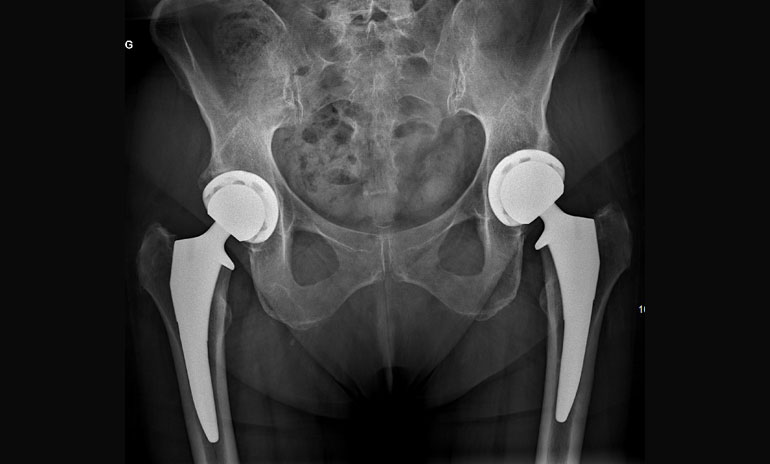Anterior Hip Replacement
What is a total hip replacement?
Total hip replacement (also called total hip arthroplasty) is a surgical procedure that involves replacing the hip joint with an internal prosthesis. The hip is a ball and socket joint composed of the acetabulum (socket) and the femoral head (ball). In a total hip replacement, both the ball and socket are replaced. In a partial hip replacement (or hemiarthroplasty), only the femoral head is replaced with a prosthesis.

What bones are replaced in a hip replacement?
A hip replacement contains two main parts: the femoral stem (which will attach to the ball) and the acetabular component (or socket).
- The acetabular component is made of metal and has a special surface that allows for the surrounding bone to grow into the component. A plastic liner is placed within the acetabular component.
- The femoral stem is also composed of metal. Some of the stems are made of gritty surface that allow for the surrounding bone to grow into the stem. This is most common in younger patients with excellent bone quality. Another type of stem is made of smooth metal and requires the use of cement to achieve stability of the stem. Lastly, a ceramic head (ball) is placed on top of the stem and will make contact with the plastic liner on the acetabular component, to make a smooth ball and socket joint.
When is the right time for hip replacement?
This answer is different for each patient. Dr. Kelly’s philosophy of care involves a lot of listening, and then educating the patient about their disease and all the treatment options. Typically, Dr. Kelly recommends trying other treatment options first before considering surgery. When those are no longer effective, surgery is discussed with the patient and is often the next step. This is a unique decision for each patient based on the disease severity, as well as their goals and desires in life. Dr. Kelly and his team offer information and support as the patient makes this decision about their own health.
What is the difference between anterior and posterior approach?
A surgical approach is the route taken through a patient’s anatomy to arrive at the hip joint. Dr. Kelly most commonly utilizes the direct anterior approach. In this technique, Dr. Kelly does not have to cut through any muscles, but rather separates them in order to gain access to the hip joint. The patient is lying on his or her back so this technique allows Dr. Kelly to easily use x-rays in surgery to be more precise. The posterior approach involves splitting the gluteal muscles then detaching some of the deeper muscles near the hip joint. This approach has a higher rate of dislocation in many studies but it does allow the surgeon to see a wide exposure of the hip joint which may be necessary with abnormal anatomy.
What are the basic steps of total hip replacement?
Dr. Kelly works closely with an anesthesiologist who will make sure the patient remains comfortable throughout surgery. Dr. Kelly makes a small incision over the front of the thigh and carefully spreads rather than cuts the muscles to expose the hip joint. The diseased portion of the top of the femur (thigh bone) is carefully removed with a saw cut through the bone. Next, the hip socket is examined. A special instrument called a reamer is placed in the hip socket and then spins in a circle to prepare a hemisphere shape in the bone. The acetabular component (socket) is placed into this area under the guidance of x-ray. The plastic liner snaps into the acetabular component. The leg is placed into a position that allows Dr. Kelly to use a different instrument to create a shape in the femur similar to the shape of the femoral stem. Finally the femoral stem is placed and the ceramic femoral head is placed on top of the stem. Dr. Kelly uses x-ray again to evaluate the length of the leg compared to the other leg. The joint capsule, muscles, and skin are closed with sutures. The patient wakes up in the operating room and is transferred to the recovery area where the rehab process begins!
What are the risk of surgery?
Complications after hip replacement are rare, but this is still a major surgery that has risks. The main risks are infection, dislocation, fracture, blood clot, nerve or blood vessel injury, and wear or loosening of the implant. Dr. Kelly will discuss surgical risk with each patient, depending on each patient’s health status and severity of disease.
What are my restrictions after surgery?
The short answer is: none. Routine running is not recommended after hip replacement to limit stress on the implant; however, occasional running is not a problem. Dr. Kelly’s patients have successfully returned to skiing, tennis, golf, pickleball, bowling, and many more activities.
At a Glance
Dr. Mick Kelly
- Board-Certified Orthopedic Surgeon
- Fellowship Training in Hip and Knee Replacement
- Author of medical publications and numerous textbook chapters
- Learn more
